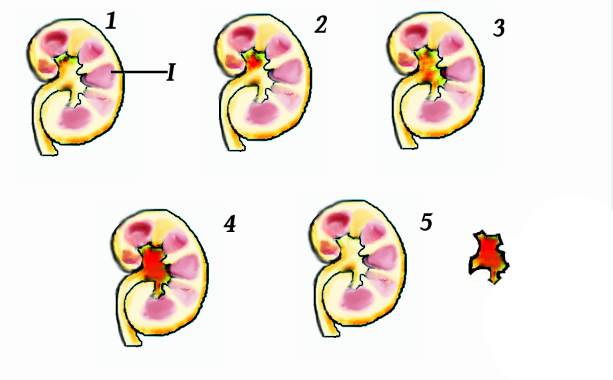Major Calyx on:
[Wikipedia]
[Google]
[Amazon]
The renal calyces ( calyx) are conduits in the
 A "
A "
Diagram at bway.net
{{kidney Kidney anatomy
kidney
In humans, the kidneys are two reddish-brown bean-shaped blood-filtering organ (anatomy), organs that are a multilobar, multipapillary form of mammalian kidneys, usually without signs of external lobulation. They are located on the left and rig ...
through which urine passes. The minor calyces form a cup-shaped drain around the apex of the renal pyramid
The renal medulla (Latin: ''medulla renis'' 'marrow of the kidney') is the innermost part of the kidney. The renal medulla is split up into a number of sections, known as the renal pyramids. Blood enters into the kidney via the renal artery, which ...
s. Urine formed in the kidney passes through a renal papilla
In humans, the kidneys are two reddish-brown bean-shaped blood-filtering organs that are a multilobar, multipapillary form of mammalian kidneys, usually without signs of external lobulation. They are located on the left and right in the retr ...
at the apex into the minor calyx; four or five minor calyces converge to form a major calyx through which urine passes into the renal pelvis
The renal pelvis or pelvis of the kidney is the funnel-like dilated part of the ureter in the kidney. It is formed by the convergence of the major calyces, acting as a funnel for urine flowing from the major calyces to the ureter. It has a mucous ...
(which in turn drains urine out of the kidney through the ureter
The ureters are tubes composed of smooth muscle that transport urine from the kidneys to the urinary bladder. In an adult human, the ureters typically measure 20 to 30 centimeters in length and about 3 to 4 millimeters in diameter. They are lin ...
).
Function
Peristalsis
Peristalsis ( , ) is a type of intestinal motility, characterized by symmetry in biology#Radial symmetry, radially symmetrical contraction and relaxation of muscles that propagate in a wave down a tube, in an wikt:anterograde, anterograde dir ...
of the smooth muscle originating in pace-maker cells originating in the walls of the calyces propels urine through the renal pelvis
The renal pelvis or pelvis of the kidney is the funnel-like dilated part of the ureter in the kidney. It is formed by the convergence of the major calyces, acting as a funnel for urine flowing from the major calyces to the ureter. It has a mucous ...
and ureter
The ureters are tubes composed of smooth muscle that transport urine from the kidneys to the urinary bladder. In an adult human, the ureters typically measure 20 to 30 centimeters in length and about 3 to 4 millimeters in diameter. They are lin ...
s to the bladder
The bladder () is a hollow organ in humans and other vertebrates that stores urine from the kidneys. In placental mammals, urine enters the bladder via the ureters and exits via the urethra during urination. In humans, the bladder is a distens ...
. The initiation is caused by the increase in volume that stretches the walls of the calyces. This causes them to fire impulses which stimulate rhythmical contraction and relaxation, called peristalsis. Parasympathetic innervation enhances the peristalsis while sympathetic innervation inhibits it.
Clinical significance
 A "
A "staghorn calculus
Kidney stone disease (known as nephrolithiasis, renal calculus disease, or urolithiasis) is a crystallopathy and occurs when there are too many minerals in the urine and not enough liquid or hydration. This imbalance causes tiny pieces of cr ...
" is a kidney stone
Kidney stone disease (known as nephrolithiasis, renal calculus disease, or urolithiasis) is a crystallopathy and occurs when there are too many minerals in the urine and not enough liquid or hydration. This imbalance causes tiny pieces of cr ...
that may extend into the renal calyces.
A renal diverticulum is diverticulum of renal calyces.
See also
*Renal medulla
The renal medulla (Latin: ''medulla renis'' 'marrow of the kidney') is the innermost part of the kidney. The renal medulla is split up into a number of sections, known as the renal pyramids. Blood enters into the kidney via the renal artery, which ...
* Renal pyramids
* Calyx (anatomy)
Calyx is a term used in animal anatomy for some cuplike areas or structures.
Etymology
Latin, from ''calyx'' (from Ancient Greek ''κάλυξ, ''case of a bud, husk").
Cnidarians
The spicules containing the basal portion of the upper tentacular ...
References
External links
* - "Posterior Abdominal Wall: Internal Structure of a Kidney" * - "Posterior Abdominal Wall: Internal Structure of a Kidney" * - "Urinary System: neonatal kidney" * ()Diagram at bway.net
{{kidney Kidney anatomy